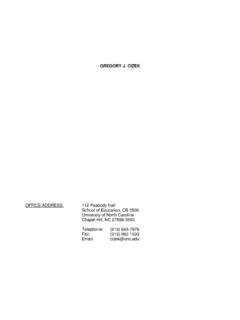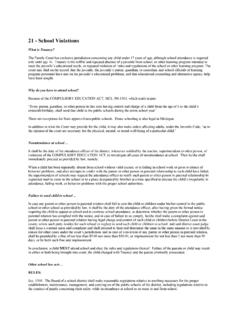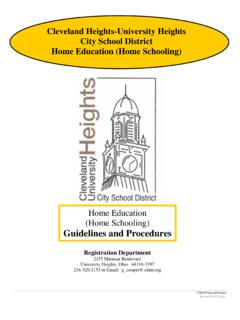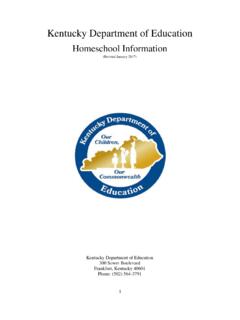Transcription of K-12 Schooling Alternatives - …
1 176 michigan IN BRIEF, 7th EditionSponsored by the michigan Nonprofit Association and the Council of michigan FoundationsK 12 Schooling AlternativesGLOSSARYC harter schoolA school, sometimes having aparticular education approach, thatis exempt from certain stateregulations; also known as a publicschool to schools of choice, anoption that parents sometimes havethat permits them to elect to sendtheir child to a school other thanthe one assigned by the allowanceThe per pupil amount of statefunding that pays for most ofschools operating schoolingEducating a child at home ratherthan sending him/her to a public orprivate choiceA form of school choice wherebyparents may send a child to apublic school outside of the schooldistrict in which they schooldistrict (ISD)
2 An educational service agencythat provides support to schooldistricts in a certain geographicarea (frequently approximatesthe county).VoucherA form of state aid that allots toparents a certain amount of publicmoney that they may use to pay fortheir children s education at of the most hotly debated topics in K 12 education is schools of choice (or school choice or, simply, choice ), whereby parents are permitted to choose thevenue in which their children will be educated. In michigan , school choice generallyrefers to the following: Interdistrict (cross-district) choice Charter schools Vouchers home schoolingInterdistrict ChoiceSince 1994, when Proposal A (the school-finance reform initiative) passed, the amountof state funding a school district receives depends more on the number of students itenrolls than previously was the case.
3 Schools now receive from the state a certain amount(the foundation allowance) per pupil; thus, if a student leaves his/her current schooldistrict for any reason, the district s state funding is reduced. Losing students can havevery serious financial consequences for a district: for example, a district receiving theminimum foundation allowance ($6,500) in FY 2001 02 will forgo $162,500 if it losesjust 25 choice in michigan has been permitted since passage of Public Act 300 of 1996,but it is not unlimited. Students may transfer only to another district that is locatedwithin (1) the boundaries of the intermediate school district (ISD) in which they live or(2) a contiguous ISD.
4 In addition, there are certain restrictions. School districts may choose whether to participate in the schools of choice pro-gram that is, whether they will accept transferring students. Districts that choose to participate must publish a list of grades in which they willaccept nonresident students and the number of students they will allow in each. Schools must accept students on a first-come-first-served basis; they may not dis-criminate on the basis of race, academic ability, or any other factor. Parents must provide their own the 1996 97 school year, the first that the law was in effect, almost 8,000 Michiganstudents attended a school outside their home district.
5 In 2001 02 the number morethan quadrupled, to about 33, the state s 554 local school districts, two-thirds (64 percent) are accepting studentsfrom outside their district. Since more districts are expected to experience decliningenrollment in coming years, it is likely that in the future more will participate with theaim of increasing their 12 Schooling ALTERNATIVESAPRIL 1, 2002177 Sponsored by the michigan Nonprofit Association and the Council of michigan FoundationsCharter SchoolsIn 1994, as part of school-finance reform, lawmakers 362 of 1993, the so-called charter-school law. Thelaw permits public school academies to be was among the first states to take such a step,and, according to one education-reform organization, theMichigan law is one of the most far-reaching in the na-tion second only to Arizona s and Delaware s in theamount of autonomy given charters, the kind allowed, andother charter schools operate under the auspices ofan authorizer, one of four types of public entity: a stateuniversity, school district, ISD, or community college.
6 Theauthorizer is responsible for monitoring the charter school sprogress and its adherence to state regulations as well asproviding other oversight; the authorizer may revoke aschool s charter if it believes the school is not performingsatisfactorily. The number of charter schools that stateuniversities collectively may authorize is 150, and thisceiling was reached in FY 2000 01, meaning that univer-sities may not charter additional schools unless an exist-ing one closes. Although there is no cap on the other typesof authorizers, they are confined to authorizing chartersin their service area, whereas a university may authorizeschools schools are subject to most of the same laws astraditional schools; for example, they must employ onlycertified teachers, are prohibited from charging tuition orteaching a religion-based curriculum, and must accept stu-dents on a first-come-first-served basis.
7 Unlike traditionalpublic schools, however, they need not (1) accept all ap-plicants if they do not have available space, which meansthey can control school and class size, (2) hire unionizedteachers, or (3) participate in collective , michigan has approximately 190 charterschools. Only a minority of michigan youngsters attendsa charter school (see Exhibit 1). The amount of state fund-ing lost to traditional schools is about $420 million (outof $11 billion).VouchersUnder a voucher system, the state would provide fundingfor parents to send their children to a school of their choice,be it public or private. A voucher system would be a sub-stantial departure from the current system, where stateaid flows only to public school districts and parents of pri-vate-school students foot the bill states Florida, Maine, Ohio, Vermont, and Wiscon-sin currently offer voucher programs that pay tuition atprivate schools.
8 Most are confined either to a specific city( , Milwaukee) or are targeted to students who have anidentifiable risk of academic failure. Six other states offertax credits for private-school expenses or scholarships, andsome observers consider this to be a form of VIII, section 2, of the michigan Constitution spe-cifically prohibits using public monies to fund private- orreligious-school education. This means that to have avoucher system in michigan , a majority of voters mustapprove a constitutional amendment. In 2000 Michiganvoters turned down, by more than a two-to-one margin, aballot proposal to institute a sweeping voucher programin the state.
9 The measure would have allowed vouchersin any district having a graduation rate of less than two-thirds or in which a majority of voters approved a vouchersystem. Potentially, all of the state s districts could havebeen voucher districts. Had it passed, the amendmentwould have created the first statewide voucher system inthe nation in which any district and any student livingthere could Supreme Court currently is considering a piv-otal voucher case, Zelman v. Simmons-Harris, regardingwhether a six-year-old voucher program in Cleveland vio-lates the Constitution because 96 percent of the studentsin this state-sponsored program attend schools that havea religious affiliation.
10 If the decision, expected in July 2002,upholds the program, it could lead to an increase of suchEXHIBIT 1. Enrollment in MichiganPublic Charter and TraditionalSchools, FY 2001 02 SOURCE: House Fiscal Agency, using data from the michigan Department equivalent, blended pupil numbers; these are the figures used to calculateschools state million of all studentsCharter schools64,500 of all studentsK 12 Schooling ALTERNATIVES178 michigan IN BRIEF, 7th EditionSponsored by the michigan Nonprofit Association and the Council of michigan Foundationsprograms nationwide; if it rules against the program, thequestion of whether vouchers may be used at religious-affiliated schools may be laid to rest SchoolingThe Revised School Code of 1976 states that a child isnot required to attend a public school if s/he isbeing educated by his or her parent or legal guard-ian at the child s home in an organized educationalprogram that is appropriate given the age, intelli-gence, ability, and any psychological limitations ofthe child, in the subject areas of reading, math-ematics, science, history, civics, literature, writing.









